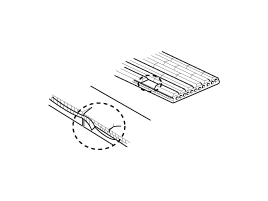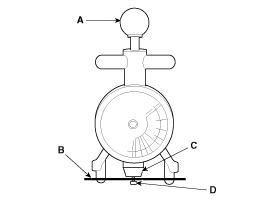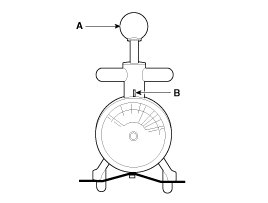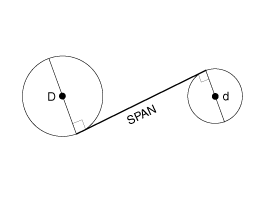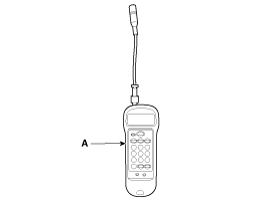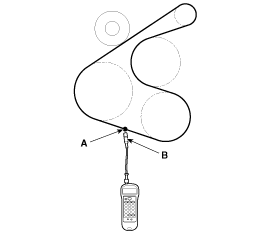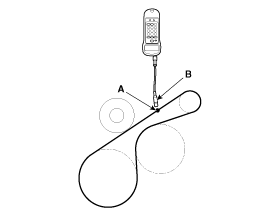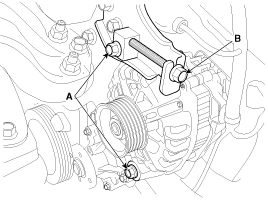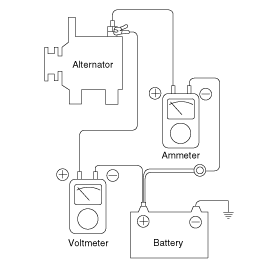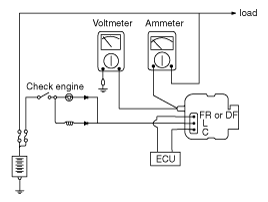 Hyundai Accent: Repair procedures
Hyundai Accent: Repair procedures
Hyundai Accent RB (2010-2018) Service Manual / Engine Electrical System / Charging System / Repair procedures
On-vehicle Inpection
|
Check The Battery Terminals And Fuses
| 1. |
Check that the battery terminals are not loose or
corroded.
|
| 2. |
Check the fuses for continuity.
|
Inspect Drive Belt
| 1. |
Visually check the belt for excessive wear, frayed
cords etc.
If any defect has been found, replace the drive belt.
|
Drive belt tension measurement and adjustment
| Belt tension measurement (Gamma 1.4/1.6) |
Measure the belt tension using a mechanical tension gauge
or a sonic tension meter.
Tension
New belt: 882.6 ~ 980.7N (90 ~ 100kg, 198.4 ~ 220.5lb)
Used belt: 637.4 ~ 735.5N (65 ~ 75kg, 143.3 ~ 165.3lb)
|
|
| Using a mechanical tension gauge (BT-33-73F, BTG-2 type) |
| 1. |
While pressing the handle (A) of the gauge, insert
the belt (B) between pulley and pulley (or idler) into the gap between
spindle (C) and hook (D).
|
| 2. |
After releasing the handle (A), read a value on the
dial pointed by the indicator (B).
|
| Using a sonic tension meter (U-505/507 type) |
| 1. |
Input the belt specifications into the tension meter.
|
|||||||||||||||||||||
| 2. |
Locate the micro phone (B) close to the center of
belt span (A) and bounce the belt by finger 2~3 times. Read a value
on the display.
[With A/C]
[Without A/C]
|
| If adjustment is necessary : |
| 1. |
Loosen the mounting bolts (A).
|
| 2. |
Tighten the adjusting bolt(B) clockwise in loose
tension ; loosen the bolt counterclockwise in high tension.
|
| 3. |
Recheck tension of the belt.
|
| 4. |
After adjusting tension, tighten the through bolts.
|
Visually Check Alternator Wiring And Listen For Abnormal Noises
| 1. |
Check that the wiring is in good condition.
|
| 2. |
Check that there is no abnormal noise from the alternator
while the engine is running.
|
Check Discharge Warning Light Circuit
| 1. |
Warm up the engine and then turn it off.
|
| 2. |
Turn off all accessories.
|
| 3. |
Turn the ignition switch "ON". Check that the discharge
warning light is lit.
|
| 4. |
Start the engine. Check that the light is lit.
If the light does not go off as specified, troubleshoot
the discharge light circuit.
|
Inspect Charging System
Voltage Drop Test Of Alternator Output Wire
This test determines whether or not the wiring between the
alternator "B" terminal and the battery (+) terminal is good by the voltage
drop method.
Preparation
| 1. |
Turn the ignition switch to "OFF".
|
| 2. |
Disconnect the output wire from the alternator "B"
terminal. Connect the (+) lead wire of ammeter to the "B" terminal of
alternator and the (-) lead wire of ammeter to the output wire. Connect
the (+) lead wire of voltmeter to the "B" terminal of alternator and
the (-) lead wire of voltmeter to the (+) terminal of battery.
|
Test
| 1. |
Start the engine.
|
| 2. |
Turn on the headlamps and blower motor, and set the
engine speed until the ammeter indicates 20A.
And then, read the voltmeter at this time.
|
Result
| 1. |
The voltmeter may indicate the standard value.
|
| 2. |
If the value of the voltmeter is higher than expected
(above 0.2V max.), poor wiring is suspected. In this case check th e
wiring from the alternator "B" terminal to the battery (+) terminal.
Check for loose connections, color change due to an over-heated harness,
etc. Correct them before testing again.
|
| 3. |
Upon completion of the test, set the engine speed
at idle.
Turn off the headlamps, blower motor and the ignition
switch.
|
Output Current Test
This test determines whether or not the alternator gives
an output current that is equivalent to the normal output.
Preparation
| 1. |
Prior to the test, check the following items and
correct as necessary.
Check the battery installed in the vehicle to ensure
that it is good condition. The battery checking method is described
in the section "Battery".
The battery that is used to test the output current
should be one that has been partially discharged. With a fully charged
battery, the test may not be conducted correctly due to an insufficient
load.
Check the tension of the alternator drive belt. The
belt tension check method is described in the section "Inspect drive
belt".
|
| 2. |
Turn off the ignition switch.
|
| 3. |
Disconnect the battery ground cable.
|
| 4. |
Disconnect the alternator output wire from the alternator
"B" terminal.
|
| 5. |
Connect a DC ammeter (0 to 150A) in series between
the "B" terminal and the disconnected output wire. Be sure to connect
the (-) lead wire of the ammeter to the disconnected output wire.
|
| 6. |
Connect a voltmeter (0 to 20V) between the "B" terminal
and ground. Connect the (+) lead wire to the alternator "B" terminal
and (-) lead wire to a good ground.
|
| 7. |
Attach an engine tachometer and connect the battery
ground cable.
|
| 8. |
Leave the engine hood open.
|
Test
| 1. |
Check to see that the voltmeter reads as the same
value as the battery voltage. If the voltmeter reads 0V, and the open
circuit in the wire between alternator "B" terminal and battery (+)
terminal or poor grounding is suspected.
|
| 2. |
Start the engine and turn on the headlamps.
|
| 3. |
Set the headlamps to high beam and the heater blower
switch to HIGH, quickly increase the engine speed to 2,500 rpm and read
the maximum output current value indicated by the ammeter.
|
Result
| 1. |
The ammeter reading must be higher than the limit
value. If it is lower but the alternator output wire is in good condition,
remove the alternator from the vehicle and test it.
|
| 2. |
Upon completion of the output current test, lower
the engine speed to idle and turn off the ignition switch.
|
| 3. |
Disconnect the battery ground cable.
|
| 4. |
Remove the ammeter and voltmeter and the engine tachometer.
|
| 5. |
Connect the alternator output wire to the alternator
"B" terminal.
|
| 6. |
Connect the battery ground cable.
|
Regulated Voltage Test
The purpose of this test is to check that the electronic
voltage regulator controls voltage correctly.
Preparation
| 1. |
Prior to the test, check the following items and
correct if necessary.
Check that the battery installed on the vehicle is
fully charged. The battery checking method is described in the section
"Battery".
Check the alternator drive belt tension. The belt
tension check method is described in the section "Inspect drive belt".
|
| 2. |
Turn ignition switch to "OFF".
|
| 3. |
Disconnect the battery ground cable.
|
| 4. |
Connect a digital voltmeter between the "B" terminal
of the alternator and ground. Connect the (+) lead of the voltmeter
to the "B" terminal of the alternator. Connect the (-) lead to good
ground or the battery (-) terminal.
|
| 5. |
Disconnect the alternator output wire from the alternator
"B" terminal.
|
| 6. |
Connect a DC ammeter (0 to 150A) in series between
the "B" terminal and the disconnected output wire.
Connect the (-) lead wire of the ammeter to the disconnected
output wire.
|
| 7. |
Attach the engine tachometer and connect the battery
ground cable.
|
Test
| 1. |
Turn on the ignition switch and check to see that
the voltmeter indicates the following value.
If it reads 0V, there is an open circuit in the wire
between the alternator "B" terminal and the battery and the battery
(-) terminal.
|
| 2. |
Start the engine. Keep all lights and accessories
off.
|
| 3. |
Run the engine at a speed of about 2,500 rpm and
read the voltmeter when the alternator output current drops to 10A or
less
|
Result
| 1. |
If the voltmeter reading dosen't agree with the standard
value, the voltage regulator or the alternator is faulty.
|
| 2. |
Upon completion of the test, reduce the engine speed
to idle, and turn off the ignition switch.
|
| 3. |
Disconnect the battery ground cable.
|
| 4. |
Remove the voltmeter and ammeter and the engine tachometer.
|
| 5. |
Connect the alternator output wire to the alternator
"B" terminal.
|
| 6. |
Connect the battery ground cable.
|
 Description and Operation
Description and Operation
Description
The charging system included a battery, an alternator with
a built-in regulator, and the charging indicator light and wire.
The Alternator has eight built-in diodes, each rectif ...
 Alternator. Components and Components
Location
Alternator. Components and Components
Location
Components
1. Nut
2. Pulley
3. Spacer
4. Front bracket
5. Front bearing
6. Stator
7. Rotor
8. Rear bearing
9. Rear bracket
10. Brush holder assem ...
See also:
Removal
Replacing an on/off solenoid valve (SS-A, SS-B) does not require
additional hydraulic pressure adjustment; however, the hydraul ...
Installation
•
Install the component with the specified
torques.
•
...
Maintenance services
You should exercise the utmost care to prevent damage to your vehicle and injury
to yourself whenever performing any maintenance or inspection procedures.
Should you have any doubts concerning the ...
Hyundai Accent Manuals
- Hyundai Accent 2017-2022 Service Manual
- Hyundai Accent 2010-2025 Owners Manual
- Hyundai Accent 2010-2025 Service Manual
© 2011-2025 Copyright www.hamanual.com

